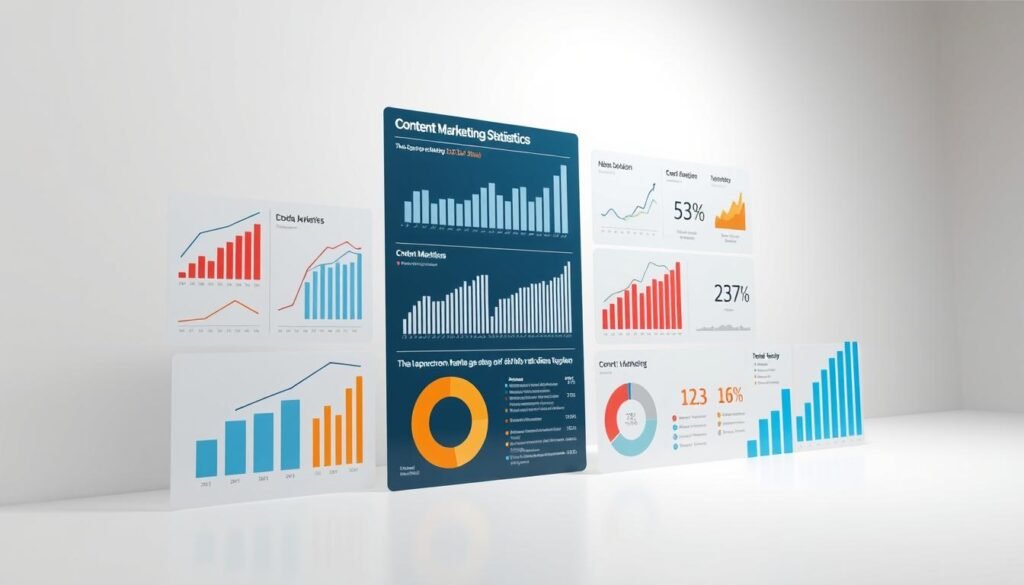Did you know businesses with a documented plan are 313% more likely to succeed? Content drives engagement, builds trust, and fuels growth in today’s digital world. Whether you’re a startup or an established brand, a well-crafted approach can set you apart.
Over 70% of marketers now prioritize content efforts, but many struggle with consistency. The key lies in aligning your goals with audience needs. This means blending creativity with data, adapting to trends like AI, and focusing on measurable results.
Ready to transform your efforts? This guide breaks down actionable steps to craft a strategy that delivers. From defining objectives to optimizing performance, you’ll learn to turn content into a powerful growth engine.
What Is a Content Marketing Strategy?
Strategic content isn’t just about posting—it’s about purpose. A content marketing strategy is the blueprint for creating, managing, and scaling material that drives real business results. Unlike random updates, it aligns every piece with your target audience and long-term vision.

The Core Purpose of Strategic Content
Think of it like a GPS for your brand’s voice. Carl Broadbent’s podcast failed because it lacked direction—no schedule, no audience research. In contrast, ESPN’s TimesMachine archives show how historical content can fuel modern engagement when planned intentionally.
Ayomide Joseph, a SaaS growth expert, puts it simply: “Strategy answers the how.” It bridges creativity and analytics, ensuring resources like time and budget yield measurable outcomes.
How It Differs From General Content Creation
Random posts might get likes; strategic content builds loyalty. Here’s the breakdown:
| General Content | Strategic Content |
|---|---|
| Reactive (trend-chasing) | Proactive (goal-driven) |
| One-off pieces | Clusters and pillar pages |
| Unmeasured impact | ROI tracking |
| Generic messaging | Authentic differentiation |
For example, The New York Times uses strategy to repurpose investigative journalism into documentaries—maximizing reach without extra costs. That’s the power of planning.
Today’s winners focus on valuable content that educates or entertains. They don’t just shout into the void; they listen, adapt, and refine.
Why Your Business Needs a Content Marketing Plan
Without a roadmap, even the best content gets lost in the digital noise. A content marketing plan transforms scattered efforts into a growth engine. Consider this: a literary company boosted traffic by 260% after implementing one.

Alignment Across Teams and Goals
Documented strategies unite departments. Sales, customer success, and marketing teams work toward shared objectives. Research shows 65% of successful teams document plans versus 14% of struggling ones.
Benefits of alignment:
- Consistent messaging builds brand awareness.
- Cross-functional collaboration speeds up lead conversion.
- Content supports sales enablement (e.g., case studies, white papers).
Resource Optimization and ROI
Ad-hoc creation wastes budgets. AdvisorStream achieved a 200% view increase by licensing strategic content. HubSpot reports 90% of marketers will maintain or increase budgets in 2025.
| Ad-Hoc Content | Strategic Content |
|---|---|
| High cost per piece | Lower cost through repurposing |
| Unpredictable results | Measurable ROI (e.g., generate leads) |
| 15% struggle with lead generation | SEO-driven traffic growth |
Stop the “random acts of content.” Invest in planning to maximize every dollar and minute.
Key Content Marketing Statistics You Should Know
Numbers don’t lie—understanding content marketing stats can shape your success. From budgets to engagement rates, data reveals what drives real impact. Let’s dive into the numbers that matter.

Industry Investment Trends
Brands are doubling down on quality. Research shows 78% prioritize content excellence over quantity. Budgets reflect this shift:
- 90% focus on brand awareness, while only 55% target conversions.
- Short-form video content delivers 17% higher engagement than static posts.
- Voice search adoption grows steadily, with 13% of users leveraging it for queries.
Performance Benchmarks
Not all formats perform equally. Thought leadership influences 47% of product discoveries. Compare organic and paid efforts:
| Metric | Organic Content | Paid Content |
|---|---|---|
| Cost Efficiency | 62% cheaper than traditional ads | Higher upfront cost |
| Audience Growth | 40% podcast listenership increase | Faster short-term reach |
| Engagement | 27% boost with curated emails | Lower retention rates |
Repurposing amplifies results—60% of brands reuse material for efficiency. Whether B2B or B2C, a solid marketing strategy leans on data, not guesses.
Essential Elements of a Content Strategy Plan
Every winning strategy starts with clear foundations—here’s what matters most. A content strategy thrives when seven components work together: goals, audience insights, audits, formats, workflows, metrics, and governance. Miss one, and results suffer.
Goal Setting and Audience Identification
SMART goals turn vague ideas into action. HubSpot’s template helps define objectives like “Increase organic traffic by 25% in Q3.” Pair this with deep audience research. WPForms data shows 68% of brands refine buyer personas using surveys.
Trengo, a SaaS tool, aligns content with user journeys. Their guides address specific pain points, like reducing ticket resolution time. This focus drives 40% more conversions.
Content Audit and Gap Analysis
A content audit reveals what’s working. Tools like Screaming Frog or SEMrush analyze performance metrics. Look for high-traffic pieces to repurpose or outdated posts to update.
Gap analysis uncovers opportunities. Ahrefs’ Content Explorer identifies topics competitors rank for—but you don’t. Buzzsumo highlights trending formats, like video tutorials in your niche.
Pitfall to avoid: Only 62% of B2B teams document their strategy. Without guidelines, consistency crumbles.
Your Content Plan Checklist
- Define 3–5 SMART goals
- Develop detailed buyer personas
- Audit existing assets with SEO tools
- Research competitor gaps
- Choose content types (e.g., blogs, videos)
- Assign team roles and workflows
- Set KPIs (traffic, engagement, leads)
Preparing Your Content Marketing Foundation
Your content’s impact hinges on two often-neglected preparation steps. Before launching campaigns, establishing brand guidelines and analyzing competitors sets the stage for success. These foundations ensure every piece aligns with your identity while filling market gaps competitors miss.
Developing Brand Guidelines
Consistency builds brand awareness across all touchpoints. HubSpot’s Content Hub AI demonstrates this—their system enforces voice, tone, and visual identity automatically. Your guidelines should cover:
- Voice & tone: Formal vs. conversational? Humorous or professional?
- Visual identity: Color palettes, typography, image styles
- Messaging pillars: 3-5 core themes reflecting business goals
Legal compliance matters too. GDPR and copyright laws affect content creation. Document usage rights for stock assets and disclosure requirements for partnerships.
Conducting Competitive Research
Aura Security dominated their niche by benchmarking competitors’ weaknesses. Their team used SEMrush’s content gap tool to identify 47 underserved topics. Effective analysis examines:
| Research Focus | Tools & Methods | Outcome |
|---|---|---|
| Share of voice | Ahrefs Domain Rating | Identify market leaders |
| Content gaps | SEMrush Topic Research | Find untapped opportunities |
| Format analysis | Buzzsumo Engagement Metrics | See what formats perform best |
Build content clusters around gaps you discover. For example, if competitors lack video tutorials, create a series targeting those queries. Avoid imitation—differentiate through unique data or storytelling angles.
Use this SWOT framework to organize findings:
- Strengths: What competitors do exceptionally well
- Weaknesses: Missing topics or poor-quality content
- Opportunities: Emerging trends they haven’t capitalized on
- Threats: Their most engaging content types
These steps prepare your editorial calendar with confidence. You’ll publish distinctive, on-brand material that stands out in crowded markets.
How to Define Your Content Marketing Goals
Goal-setting separates thriving brands from those stuck in guesswork. Clear objectives turn content marketing efforts into growth engines. Whether boosting traffic or nurturing leads, every piece should serve a purpose.
Using the SMART Framework
Vague goals like “get more traffic” fail. SMART criteria ensure precision:
- Specific: “Increase ebook downloads by 25%.”
- Measurable: Track via Google Analytics.
- Achievable: Base targets on past performance.
- Relevant: Align with business goals (e.g., lead quality).
- Time-bound: “Achieve in Q4 2024.”
HubSpot’s Aja Frost ties goals to revenue. For example, a 10% blog conversion rate might drive $50K in sales. Use Asana templates to map goals to KPIs like MQLs or trial sign-ups.
Aligning With Business Objectives
Nextiva’s 300% lead increase came from linking content to sales funnels. Their marketing plan focused on bottom-funnel guides, like “CRM Comparison Checklists.”
| Goal Type | Content Strategy | KPIs |
|---|---|---|
| Brand Awareness | Social media snippets, infographics | Impressions, shares |
| Lead Generation | Gated whitepapers, webinars | Form submissions, generate leads |
Avoid vanity metrics. Track what moves the needle—like demo requests versus page views. Apply the 70-20-10 rule: 70% of resources to proven tactics, 20% to experiments, 10% to moonshots.
Executive buy-in matters. Present goals as revenue drivers, not just “blog posts.” When teams see content’s impact on business goals, budgets and collaboration follow.
Understanding Your Target Audience
The difference between generic posts and high-converting material? Deep audience understanding. Your target audience isn’t a vague group—it’s real people with specific needs. Tailoring content to their behaviors and challenges boosts engagement and loyalty.
Creating Detailed Buyer Personas
Buyer personas turn data into actionable profiles. Start with surveys, interviews, and analytics. HubSpot’s persona generator simplifies this—input demographics, goals, and frustrations to build a blueprint.
Example: A SaaS company might segment users into technical admins (focused on API integrations) and business leaders (prioritizing ROI). Each persona needs unique content angles.
- Psychographics > Demographics: Values and pain points matter more than age/location.
- Update quarterly—SEMrush tracks shifting keyword trends to refine personas.
Mapping Customer Pain Points
The Jobs-to-Be-Done framework reveals unmet needs. Trengo’s customer journey content reduced support tickets by 30% by addressing specific frustrations, like slow response times.
Try empathy mapping for content creation:
| Pain Point | Content Solution |
|---|---|
| Confusing software setup | Step-by-step video tutorials |
| Budget constraints | ROI calculators and case studies |
In digital marketing, relevance wins. Tools like Buzzsumo highlight trending formats—adapt these insights to your audience’s evolving needs.
Conducting a Comprehensive Content Audit
Your archives hold gold; a content audit reveals where to dig. Whether you’re updating old posts or finding gaps, this process maximizes ROI. Start with a clear plan to evaluate, categorize, and revitalize your material.
Evaluating Existing Content Performance
Not all pieces perform equally. Use Google Analytics 4 to group pages by traffic, bounce rate, and conversions. For example, OptinMonster boosted traffic 150% by identifying top-performing blogs with low engagement.
Apply this scoring matrix to prioritize updates:
| Criteria | High Score (3) | Medium (2) | Low (1) |
|---|---|---|---|
| Relevance | Aligns with current goals | Needs minor updates | Off-topic |
| Quality | Well-researched, error-free | Requires edits | Thin or outdated |
| Performance | High traffic/conversions | Moderate metrics | Low engagement |
Tools like SEMrush highlight technical issues. Screaming Frog crawls show broken links or missing metadata—fix these first for quick wins.
Identifying Repurposing Opportunities
Turn blogs into multi-format assets. A single pillar post can generate leads across channels. Follow this workflow:
| Original | Repurposed Format | Platform |
|---|---|---|
| Blog post | Video tutorial | YouTube |
| Whitepaper | Infographic | |
| Case study | Podcast episode | Spotify |
HubSpot’s CMS Hub tracks repurposed content performance. Focus on evergreen pieces—update statistics, add new examples, and re-share them quarterly.
Pro tip: Avoid analysis paralysis. Use the 80/20 rule—improve top 20% of assets driving 80% of results.
Choosing Your Content Types and Formats
Not all content types perform equally—choosing wisely impacts engagement. Blogs drive leads, while interactive tools boost conversions. Your strategy needs a mix of formats tailored to audience preferences and funnel stages.
Blog Posts and Long-Form Content
Blog posts generate 3x more leads than social updates. Nextiva’s pillar posts—like their VoIP comparison guide—rank for 200+ keywords. Structure matters:
- Cluster content around core topics (e.g., “CRM Basics”).
- Use data from Buzzsumo: Listicles and how-tos get 80% more shares.
- Repurpose into eBooks or newsletters for gated leads.
Visual and Interactive Content
Visual content lifts conversions by 40%. Aura Security’s ROI calculator increased demo requests by 55%. Tools like Canva simplify design. Compare formats:
| Format | Best For | ROI Boost |
|---|---|---|
| Video content | Explainer tutorials | 17% higher engagement |
| Infographics | Data-heavy topics | 30% more backlinks |
| Quizzes | Lead generation | 50% form fills |
Avoid format sprawl. Stick to 3–5 core content types—like blogs, videos, and tools—to maintain quality and consistency. Test what resonates before scaling.
Selecting the Right Distribution Channels
Great content deserves an audience; smart distribution finds them. Where you distribute content impacts visibility as much as quality. Email delivers 40% ROI compared to social media’s 28%, proving channel choice matters.
Owned vs. Earned Media Platforms
Owned media (your website, email list) offers full control and SEO benefits. AdvisorStream boosted views 200% by syndicating content across their blog and newsletter. Key advantages:
- Brand building through consistent messaging
- Higher conversion paths from gated content
- Long-term traffic from search engines
Earned media expands reach through:
| Tactic | Platform | Impact |
|---|---|---|
| Guest posting | Industry blogs | Authority building |
| HARO pitches | Journalist networks | Backlink opportunities |
| Influencer collabs | Instagram/YouTube | Trust transfer |
Social Media Strategy Integration
Each platform serves unique purposes. LinkedIn drives B2B leads, while TikTok excels at viral reach. HubSpot’s dashboard shows:
- LinkedIn: 2x higher engagement for thought leadership
- TikTok: 17% more shares for tutorial content
- Twitter: Best for real-time engagement
Paid amplification complements organic efforts. Test boosted posts on high-performing content before scaling. Always track performance with UTM parameters to measure which channels generate leads effectively.
Pro tip: Avoid spreading thin. Focus on 2-3 core platforms where your audience engages most. Quality beats quantity in content distribution.
How to Create Your Content Strategy Framework
A solid framework turns ideas into measurable results—here’s how to build yours. Whether launching a blog or scaling campaigns, structure ensures every piece aligns with goals. Follow this step-by-step process to craft a system that delivers.
Step-by-Step Development Process
Start with these nine steps to refine your content marketing strategy:
- Audit existing assets: Use SEMrush to identify top-performing posts and gaps.
- Define SMART goals: “Increase organic traffic by 30% in 6 months.”
- Map buyer journeys: HubSpot’s persona tool tailors content to pain points.
- Cluster topics: Group related posts (e.g., “SEO Basics”) for authority.
- Assign workflows: Asana templates streamline team tasks.
- Choose formats: Mix blogs, videos, and tools based on audience data.
- Set KPIs: Track conversions, not just views.
- Repurpose content: Turn webinars into infographics or LinkedIn posts.
- Review quarterly: Update outdated stats and refresh designs.
Tools for Strategy Implementation
Leverage these platforms to execute your marketing strategy efficiently:
| Tool | Use Case | ROI Example |
|---|---|---|
| HubSpot CMS | Automate publishing and tracking | Nextiva’s 300% lead boost |
| Frase | Optimize content for SEO | 40% faster research |
| ClickUp | Collaborative editorial calendar | 20% fewer missed deadlines |
AI tools like ChatGPT spark ideation, while Buzzsumo reveals trending formats. Avoid tool overload—stick to a core stack. Slack integrations keep teams aligned, like Trengo’s 30% faster approvals.
Launch with a 30-60-90 day plan: Audit in Month 1, publish clusters in Month 2, and optimize in Month 3. Your content strategy evolves with data, not guesses.
Building an Effective Content Calendar
Consistency fuels content success—an organized editorial calendar keeps efforts on track. Without one, teams miss deadlines, overlap topics, or fail to capitalize on trends. A structured plan aligns publishing with audience habits and business goals.
Editorial Planning Techniques
Choose a framework that fits your workflow. Quarterly planning suits long campaigns, while agile methods adapt to real-time trends. Tools like CoSchedule sync with email and social media, automating 80% of scheduling tasks.
| Planning Method | Best For | Tools |
|---|---|---|
| Quarterly | Evergreen content, product launches | Asana, Airtable |
| Agile | Trending topics, newsjacking | CoSchedule, Trello |
Balance your mix for sustained impact. Follow the 50/30/20 rule:
- 50% evergreen (guides, tutorials)
- 30% trending (industry news)
- 20% experimental (new formats)
Scheduling for Maximum Impact
Timing affects engagement. Data from GA4 and Google Trends reveals peak windows:
| Platform | Optimal Time | Engagement Lift |
|---|---|---|
| Tuesday 10am EST | 27% | |
| Thursday 1pm EST | 19% |
Build a backlog system. Repurpose top-performing blogs into videos or infographics. Airtable templates with approval workflows streamline content creation.
Leave 20% of slots open for flexibility. Crisis plans should include pre-approved templates for rapid response. Test and adjust your editorial calendar quarterly to maintain relevance.
With the right structure, your successful content reaches the right audience at the right moment—every time.
Content Creation and Team Workflow
Behind every high-performing content piece lies a well-oiled team workflow. Clear roles and streamlined processes prevent bottlenecks while maintaining quality. Whether you’re a solo creator or managing a full content team, structure matters.
Assigning Roles and Responsibilities
The RACI model clarifies accountability in content creation:
- Responsible: Writers and designers who create content
- Accountable: Editor approving final versions
- Consulted: Subject matter experts providing input
- Informed: Stakeholders receiving updates
ClickUp templates help visualize stage gates—from ideation to publishing. Trengo automated approvals, cutting their production processes by 40%.
Streamlining Production Processes
AI tools like Jasper accelerate drafting without sacrificing quality. For specialized needs, platforms like Contently connect you with vetted freelancers.
Cross-team collaboration boosts impact. Sales teams often need battle cards—concise guides addressing customer objections. Marketing should provide these regularly.
Implement a quality checklist:
- SEO optimization (keywords, meta tags)
- Readability scores (Flesch 60+)
- Brand voice consistency
Weekly syncs prevent silos. Use Git-style version control for assets—especially when multiple editors work on files.
When scaling, consider:
| Option | Best For |
|---|---|
| Freelance writers | Niche expertise projects |
| Agencies | End-to-end campaign management |
The right structure turns chaos into predictable, high-quality output. Your audience will notice the difference.
Content Distribution and Promotion Tactics
Distribution transforms your content from hidden gem to growth engine. Without strategic amplification, even stellar pieces fade in the noise. Focus on channels that align with your audience’s habits and business goals.
Multi-Channel Distribution Strategies
Match formats to funnel stages for maximum impact. Top-of-funnel audiences engage with infographics, while decision-makers prefer case studies.
LinkedIn Articles vs. Pulse: Long-form posts on your profile (Articles) build authority. Pulse updates reach broader networks but vanish faster. Mix both for balance.
Email Segmentation: Segment lists by behavior:
- New subscribers: Welcome series with top-performing blogs.
- Active users: Gated guides to generate leads.
- Inactive contacts: Re-engagement campaigns.
Influencer Co-Creation: Partner with micro-influencers (10K–50K followers) for authentic reach. A fintech brand saw 40% higher conversions using this tactic.
Amplification Through Paid Promotion
Boost high-performing organic content with targeted ads. Nextiva’s syndication strategy drove 300% more traffic by repurposing blogs into native ads.
| Tactic | Platform | ROI |
|---|---|---|
| Retargeting | Meta/Google Ads | 22% lower CPA |
| PR Distribution | Newswire Services | 3x backlinks |
UTM Best Practices: Tag URLs to track sources. Use consistent naming (e.g., utm_source=linkedin). Avoid “spray-and-pray”—target niches where your audience thrives.
Dark Social Tracking: Bitly or SocialBee measures shares via messaging apps. 35% of referrals come from these untraceable links.
Measuring and Optimizing Your Strategy
Data-driven decisions separate winning strategies from wasted efforts. Tracking the right metrics transforms your content marketing into a growth engine. Focus on actionable insights, not vanity numbers.
Key Performance Indicators to Track
Not all metrics matter equally. HubSpot’s First Source attribution reveals which content drives conversions. Prioritize these four categories:
- Traffic: Unique visitors, page views, and sources
- Engagement: Time on page, bounce rate, social shares
- Conversion: Lead generation rates, form submissions
- Revenue: Pipeline influence and closed deals
Implement a content scoring system:
| Factor | Weight |
|---|---|
| Quality (research depth) | 30% |
| Relevance (audience fit) | 25% |
| Performance (KPIs met) | 45% |
Continuous Improvement Methods
A SaaS company reduced churn 22% by updating help center content quarterly. Follow their approach:
- Run monthly A/B tests on headlines and CTAs
- Analyze cohort performance over 6-month periods
- Use predictive analytics to prioritize updates
Pro tip: Avoid data overload. Focus on 3-5 metrics that align with business goals. Tools like Google Data Studio simplify reporting.
Your monthly review checklist should include:
- Top/low-performing content analysis
- SEO ranking changes
- Conversion path optimizations
Continuous improvement turns good marketing strategy into exceptional results. Measure, learn, and adapt.
Conclusion
Your journey toward impactful content starts with action. A strong content marketing strategy blends planning, creativity, and data. Focus on seven pillars: goals, audience, audits, formats, workflows, distribution, and metrics.
Consistency compounds results. Brands with documented plans see 313% higher success rates. Publish successful content regularly, and track performance to refine efforts.
Next steps? Audit existing assets, align with business goals, and measure ROI. Use free tools like HubSpot templates or Google Analytics.
Ready to get started? Download our content calendar template and KPI dashboard. Iterate based on data, and watch your efforts scale.






